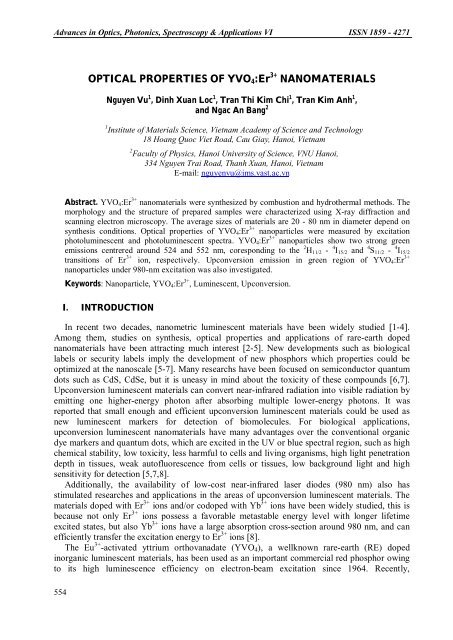INFLUENCE OF REACTION TEMPERATURE ON OPTICAL ...
INFLUENCE OF REACTION TEMPERATURE ON OPTICAL ...
INFLUENCE OF REACTION TEMPERATURE ON OPTICAL ...
You also want an ePaper? Increase the reach of your titles
YUMPU automatically turns print PDFs into web optimized ePapers that Google loves.
Advances in Optics, Photonics, Spectroscopy & Applications VI ISSN 1859 - 4271<strong>OPTICAL</strong> PROPERTIES <strong>OF</strong> YVO 4 :Er 3+ NANOMATERIALSNguyen Vu 1 , Dinh Xuan Loc 1 , Tran Thi Kim Chi 1 , Tran Kim Anh 1 ,and Ngac An Bang 21 Institute of Materials Science, Vietnam Academy of Science and Technology18 Hoang Quoc Viet Road, Cau Giay, Hanoi, Vietnam2 Faculty of Physics, Hanoi University of Science, VNU Hanoi,334 Nguyen Trai Road, Thanh Xuan, Hanoi, VietnamE-mail: nguyenvu@ims.vast.ac.vnAbstract. YVO 4 :Er 3+ nanomaterials were synthesized by combustion and hydrothermal methods. Themorphology and the structure of prepared samples were characterized using X-ray diffraction andscanning electron microscopy. The average sizes of materials are 20 - 80 nm in diameter depend onsynthesis conditions. Optical properties of YVO 4 :Er 3+ nanoparticles were measured by excitationphotoluminescent and photoluminescent spectra. YVO 4 :Er 3+ nanoparticles show two strong greenemissions centrered around 524 and 552 nm, coresponding to the 2 H 11/2 - 4 I 15/2 and 4 S 11/2 - 4 I 15/2transitions of Er 3+ ion, respectively. Upconversion emission in green region of YVO 4 :Er 3+nanoparticles under 980-nm excitation was also investigated.Keywords: Nanoparticle, YVO 4 :Er 3+ , Luminescent, Upconversion.I. INTRODUCTI<strong>ON</strong>In recent two decades, nanometric luminescent materials have been widely studied [1-4].Among them, studies on synthesis, optical properties and applications of rare-earth dopednanomaterials have been attracting much interest [2-5]. New developments such as biologicallabels or security labels imply the development of new phosphors which properties could beoptimized at the nanoscale [5-7]. Many researchs have been focused on semiconductor quantumdots such as CdS, CdSe, but it is uneasy in mind about the toxicity of these compounds [6,7].Upconversion luminescent materials can convert near-infrared radiation into visible radiation byemitting one higher-energy photon after absorbing multiple lower-energy photons. It wasreported that small enough and efficient upconversion luminescent materials could be used asnew luminescent markers for detection of biomolecules. For biological applications,upconversion luminescent nanomaterials have many advantages over the conventional organicdye markers and quantum dots, which are excited in the UV or blue spectral region, such as highchemical stability, low toxicity, less harmful to cells and living organisms, high light penetrationdepth in tissues, weak autofluorescence from cells or tissues, low background light and highsensitivity for detection [5,7,8].Additionally, the availability of low-cost near-infrared laser diodes (980 nm) also hasstimulated researches and applications in the areas of upconversion luminescent materials. Thematerials doped with Er 3+ ions and/or codoped with Yb 3+ ions have been widely studied, this isbecause not only Er 3+ ions possess a favorable metastable energy level with longer lifetimeexcited states, but also Yb 3+ ions have a large absorption cross-section around 980 nm, and canefficiently transfer the excitation energy to Er 3+ ions [8].The Eu 3+ -activated yttrium orthovanadate (YVO 4 ), a wellknown rare-earth (RE) dopedinorganic luminescent materials, has been used as an important commercial red phosphor owingto its high luminescence efficiency on electron-beam excitation since 1964. Recently,554















